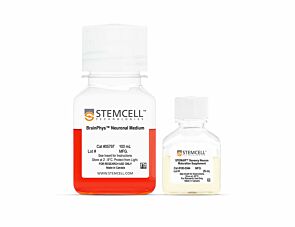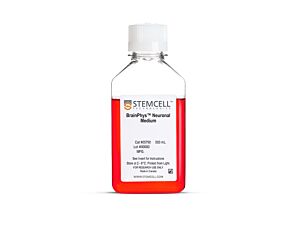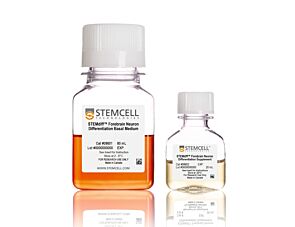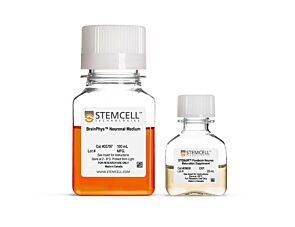STEMdiff™ Sensory Neuron Differentiation Kit
Differentiation kit for the generation of sensory neuronal precursors from human iPS cell-derived neural crest cells

Request Pricing
Thank you for your interest in this product. Please provide us with your contact information and your local representative will contact you with a customized quote. Where appropriate, they can also assist you with a(n):
Estimated delivery time for your area
Product sample or exclusive offer
In-lab demonstration
-
 STEMdiff™ Neural Crest Differentiation Kit
STEMdiff™ Neural Crest Differentiation KitCell culture kit for establishment of hPSC-derived neural crest cells
-
 STEMdiff™ Sensory Neuron Maturation Kit
STEMdiff™ Sensory Neuron Maturation KitMaturation kit for generation of functional sensory neurons from human iPS cell-derived sensory neuronal precursor cells
-
Labeling Antibodies
Compatible antibodies for purity assessment of isolated cells
Overview
Data Figures

Figure 1. Schematic for the STEMdiff™ Sensory Neuron Culture System Protocol
Sensory neuron precursors can be generated in 6 days from hPSC-derived neural crest cells. For the generation of neural crest cells, see documentation for STEMdiff™ Neural Crest Differentiation Kit (Catalog #08610). For the maturation of sensory neuron precursors to sensory neurons, see the PIS.

Figure 2. STEMdiff™ Sensory Neuron Kits Promote Differentiation Across Multiple Embryonic Stem and Induced Pluripotent Stem Cell Lines
NCCs generated from hPSCs in mTeSR™ Plus using the STEMdiff™ Neural Crest Differentiation Kit were differentiated and matured to sensory neurons using the STEMdiff™ Sensory Neuron Differentiation and Maturation Kits. (A) Sensory neurons were generated after hPSC-derived NCCs were cultured with the STEMdiff™ Sensory Neuron Differentiation Kit for 6 days and then the STEMdiff™ Sensory Neuron Maturation Kit for 6 days. The resulting cultures contain a population of cells expressing sensory neuron markers peripherin (green) and BRN3A (red) along with (B) neuronal marker class III β-tubulin (TUJ1, red). (C) Midbrain neuron controls generated with STEMdiff™ Midbrain Neuron Differentiation and Maturation Kits do not have detectable peripherin (green) or BRN3A (red) expression, although they express (D) neuronal marker class III β-tubulin (TUJ1, red). Nuclei are labeled with DAPI (blue). Human ES and iPS cell lines were maintained in either mTeSR™1, TeSR™-E8™, or mTeSR™ Plus and differentiated with STEMdiff™ Neural Crest Differentiation Kit, followed by STEMdiff™ Sensory Neuron Differentiation and Maturation Kits. The percentage expression of (E) BRN3A+ and (F) TUJ1+ cells in the resulting cultures was quantified. This differentiation generated BRN3A+ sensory neurons (25.3% ± 6.9%, mean ± SEM; n=7 cell lines, 3 - 23 replicates per condition) that expressed neuronal marker class III β-tubulin (TUJ1; 90.3% ± 4.1%, mean ± SEM; n=4 cell lines, 3 - 12 replicates per condition). Numbers are % positive over total DAPI in a tiled image. NCCs = neural crest cells; hPSCs = human pluripotent stem cells; ES = embryonic stem; iPS = induced pluripotent stem
Protocols and Documentation
Find supporting information and directions for use in the Product Information Sheet or explore additional protocols below.
Applications
This product is designed for use in the following research area(s) as part of the highlighted workflow stage(s). Explore these workflows to learn more about the other products we offer to support each research area.
Resources and Publications
Educational Materials (11)
Related Products
-
 NeuroCult™ SM1 Without Vitamin A
NeuroCult™ SM1 Without Vitamin ASupplement (50X) without vitamin A for the culture of neural progenitor cells
-
 BrainPhys™ Neuronal Medium
BrainPhys™ Neuronal MediumSerum-free neurophysiological basal medium for improved neuronal function
-
 STEMdiff™ Forebrain Neuron Differentiation ...
STEMdiff™ Forebrain Neuron Differentiation ...Differentiation kit for the generation of neuronal precursors from human ES and iPS cell-derived neural progenitor cells
-
 STEMdiff™ Forebrain Neuron Maturation Kit
STEMdiff™ Forebrain Neuron Maturation KitMaturation kit for generation of functional neurons from human ES and iPS cell-derived neuronal precursor cells
Item added to your cart

STEMdiff™ Sensory Neuron Differentiation Kit
PRODUCTS ARE FOR RESEARCH USE ONLY AND NOT INTENDED FOR HUMAN OR ANIMAL DIAGNOSTIC OR THERAPEUTIC USES UNLESS OTHERWISE STATED. FOR ADDITIONAL INFORMATION ON QUALITY AT STEMCELL, REFER TO WWW.STEMCELL.COM/COMPLIANCE.











